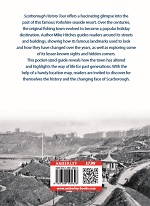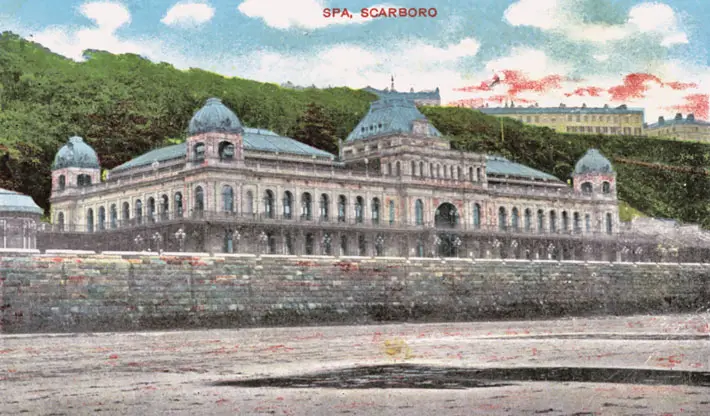Scarborough in Old Postcards and Photos

For people from Yorkshire, Scarborough has a nostalgic pull like few other places – yet the town has gone through remarkable changes in its colourful and varied history.
Taken from Scarborough History Tour, author Mike Hitches uses old postcards and photographs to chart the changing face of the ever-popular seaside holiday destination…
Scarborough Railway Station
An Edwardian exterior view of Scarborough railway station with a Falsgrave-bound open-top tram running along the south end of Westborough and approaching the junction of Northway and Valley Bridge. The station was opened in 1845 to accommodate a newly inaugurated train service from York, which, in turn, connected the town with cities in the West Riding and allowed the resort to boom as tourism expanded due to the railway. The clock on the tower was built by Potts of Leeds at a cost of £110, and remains a prominent landmark today.
The Esplanade
The Esplanade during the Edwardian period. Ladies can be seen strolling along the footpath in the fashions of the day, which must have been heavy and uncomfortable in the summer. They carried parasols to shade them from the sunshine and to prevent ‘tanning’, which was considered ‘common’ in those days. Gentlemen, seated on the bench, wore suits with either a peaked cap or straw boater hats during the summer. In the centre background is the Crown Hotel, flanked by terraces of apartments and smaller hotels. The Crown Hotel was served by a cliff railway, the first of its kind in England when opened in 1875, linking the hotel to the spa complex and saving visitors a climb of 224 steps.
Scarborough Spa Complex
The original Scarborough Spa complex was built in the 1850s to a design by Joseph Paxton. This original building did not survive due to a fire in 1876, the whole area being totally rebuilt afterwards. The new complex lasted for nearly a century until substantial refurbishment took place. The spa complex held events, often catering for Christmas parties. In earlier days, the Palm Court Orchestra would play here and the modern Spa Orchestra still entertains during the summer season.
South Bay Beach
A 1950s view of the South Bay beach at Scarborough, which is seen from the pathway that leads from the Esplanade. The promenade entrance to the Grand Hotel is visible on the left, which is long gone today. The sands are quite busy but there are very few motor vehicles running along Foreshore Road at this time – so different from today.
The Harbour
The harbour was once the commercial and industrial centre of Scarborough. The fishing boats, known as ‘cobles’ on the east coast, are seen at the quay. In the late nineteenth century, women were at the harbour gutting fish before going for sale. Visitors can be seen watching proceedings while, in the background, the rather ornate tollbooth can be seen at the entrance to the North Bay. Nowadays, the area is taken up by a fairground, but the tollbooth still stands, though it is out of use.
The Lighthouse
This 1895 view shows the lighthouse and fish quay with boats arriving from the North Sea with their fish. The lighthouse suffered some damage when the town was shelled by a German battleship in 1914 after the outbreak of the First World War. The event was used as a way of recruiting soldiers for the army, using the slogan ‘Remember Scarborough’.
The Castle
Scarborough Castle ruins are seen here in this pre-Second World War view with North Bay in the background. A castle has existed in the town since 1136 when William le Gros obtained permission from King Stephen for its construction. It was captured by Henry II and, by 1168, it became a royal fortress. Over the years since then the castle has been besieged twice during the English Civil War and it was attacked by German ships when they shelled the town in 1914, which damaged the curtain wall.
Scarborough Pier
A pier at Scarborough was built on the North Bay by the famous pier builder Eugenius Birch and completed in 1869 at a cost of £16,000. Unfortunately, the pier was built in the wrong place because this part of the coast suffered badly from stormy weather. Such an event took place on 8 January 1905 and brought about its collapse. It was never replaced.
Scarborough Station Interior
Interior of the station in the early twentieth century. The station was designed by the York & North Midland Railway architect George Andrews and contained all of the facilities expected by the nineteenth-century traveller. The overall roof, however, was only completed a few years after opening.
Church Parade
The Esplanade, Crown Hotel and terraces on a busy Edwardian summer Sunday as visitors and locals alike promenade for Church Parade. The Grand Hotel, South Bay beach and its attractions, along with the Old Town, are in the far background.

 ‘Scarborough History tour’ by Mike Hitches is published by Amberley Publishing, £7.99 paperback
‘Scarborough History tour’ by Mike Hitches is published by Amberley Publishing, £7.99 paperback




















I would like to buy old photographs of Scarborough… these are lovely. can you help me .. I need postcard size if possible….Best Regards… Kathleen Smith.